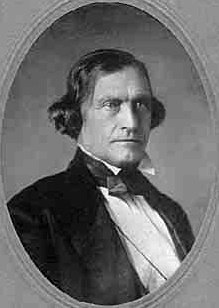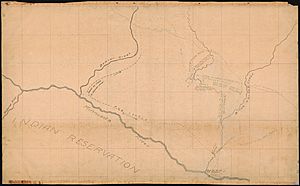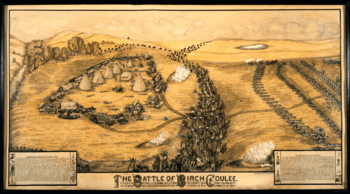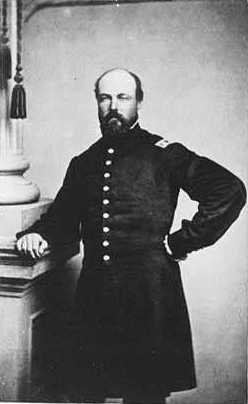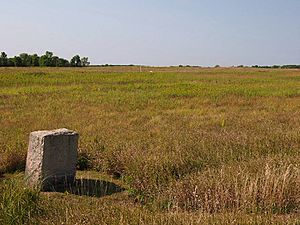Battle of Birch Coulee facts for kids
Quick facts for kids Battle of Birch Coulee |
|||||||
|---|---|---|---|---|---|---|---|
| Part of the Dakota War of 1862 | |||||||
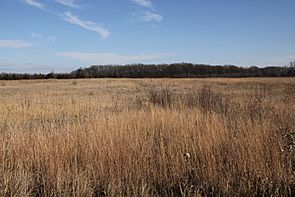 Battlefield in 2010 |
|||||||
|
|||||||
| Belligerents | |||||||
| Santee Sioux | |||||||
| Commanders and leaders | |||||||
| Captain Hiram P. Grant Captain Joseph Anderson Major Joseph R. Brown |
Gray Bird Mankato Big Eagle Red Legs |
||||||
| Strength | |||||||
| ~150 | ~200 | ||||||
| Casualties and losses | |||||||
| 13 killed 47 wounded 90+ horses killed |
2 killed unknown number wounded |
||||||
The Battle of Birch Coulee happened on September 2–3, 1862. It caused the most deaths for U.S. soldiers during the Dakota War of 1862. This battle began when a group of Dakota warriors followed a U.S. team. This team was burying dead soldiers and civilians. The U.S. group, including soldiers and civilians, set up camp in an open field. That night, about 200 Dakota warriors surrounded the camp. They attacked the Birch Coulee campsite early in the morning. This started a long fight that lasted over 30 hours. It only ended when more soldiers and cannons arrived, led by Colonel Henry Hastings Sibley.
Why the Battle Happened
After the Battle of Fort Ridgely and the Battle of New Ulm, Colonel Henry Hastings Sibley wanted to fight back. He aimed to free the settlers held by the Dakota leader Little Crow and his warriors. Sibley was training his new soldiers. He also struggled to get enough weapons. Meanwhile, families of the killed settlers reminded him that their loved ones were still unburied.
On August 29, Sibley sent two scouts north. They reported that the Dakota were camped far north near the missions. Sibley decided it was safe to send a group to bury the dead. They would go to the Lower Sioux Agency and areas near Beaver Creek and Birch Coulee. They also wanted to find out what happened to Colonel John S. Marsh and his soldiers. On August 31, 1862, he sent a burial party of 153 men from Fort Ridgely.
On the evening of August 31, warriors in Little Crow's camp disagreed on what to do next. Dakota scouts had seen more troops arriving at Fort Ridgely. After a big discussion, they decided to split into two groups. Over 100 men followed Taoyateduta Little Crow and Walker Among Sacred Stones. They went into the "Big Woods" west of Hutchinson. Their plan was to get flour from Cedar Mills. They also wanted to stop Sibley's supply wagons going to Fort Ridgely.
At the same time, Gray Bird, Mankato, Big Eagle (Wamditanka), and others led over 200 warriors. Many women and wagons also went with them. They traveled south along the river. Their goal was to collect items left behind in Little Crow's village and in New Ulm. Both places had been left empty.
The Burial Team's Mission
On August 31, Sibley sent two groups of soldiers. They also had 17 wagon drivers from Fort Ridgely. Their job was to bury the dead. One group was Company A of the 6th Minnesota Infantry Regiment. It was led by Captain Hiram P. Grant. The other was Company A of the Cullen Frontier Guards. This group had 70 mounted (on horseback) men under Captain Joseph Anderson. About 20 civilians also joined the burial team. One of them was Major Joseph R. Brown, a former Indian agent. He could use his knowledge of the Dakota people and the area. Brown himself was looking for his wife and children. He did not know they were safe with the "friendly" Dakota camp. They had been rescued by Akipa on August 23.
It was unclear who was in charge of the mission. This caused a lot of arguments after the battle. Even historians still debate it today. Captain Grant and a team member named Robert K. Boyd wrote about it. They said Captain Grant believed he was in command. Major Brown was only there to give advice. But Captain Anderson was told from the start that Major Joseph R. Brown was the leader. Anderson later said he never took any orders from Grant.
The Burial Journey
On the first day, the groups left Fort Ridgely. They headed toward the Lower Sioux Agency. After about four miles, they stopped at a farmhouse. A doctor and others had been killed there. They found many bodies on both sides of the road. They buried about 28 people.
On the second day, they buried more bodies near a log house. Then the company split up. Grant's group went north to the Beaver Creek area. They buried 30 more bodies. They also found a wounded survivor, Justina Kreiger. She had been shot in the back.
Brown and Anderson's group went to the Lower Sioux Agency. On the way, they found and buried many bodies. These included Captain John S. Marsh's men and some civilians. They crossed the river by horse and ferry. Scouts went ahead and gave the "all clear." Then the group went up the hill. They entered the ruined agency and buried more bodies. Brown and Anderson then went ahead. They checked out Little Crow's empty village. Brown stopped Anderson from burning Little Crow's house. By the end of the day, the group had buried at least 17 bodies. Several civilians went back to the fort after burying their family members.
Camp at Birch Coulee
After dark on September 1, Captain Grant set up camp. It was "on the prairie near a narrow valley known as Birch Coulee." Major Brown and Captain Anderson and their men joined the camp soon after. The two groups had buried over 75 bodies. They had not seen any Dakota people. According to Boyd, "No Indians had been seen." Officers had searched with their field glasses. Major Brown thought there were no Dakota nearby. He told the men they were safe.
No one thought much about where they camped. It was an open field near the coulee. The coulee was full of trees and tall grass. Also, most of the burial team felt safe. They did not take steps to protect themselves. They did not dig trenches or place guards far enough away to give warning.
Instead, the men put their 20 wagons in a horseshoe shape. They tied them together with ropes. This made a space about half an acre wide. The horses grazed in the open part of this area. It was about 200 yards west of the coulee. Tents were set up inside the wagons. Guards were placed just outside the wagons. Then the men went to sleep. Joseph Coursolle, a soldier with Dakota heritage, later said: "We were very tired. But even with 'Major' Brown's promise, many of us, especially those with Sioux blood, dug shallow holes to lie in. These small holes saved many lives!"
Meanwhile, the Dakota group had reached the Lower Sioux Agency that afternoon. This group included Gray Bird, Mankato, Big Eagle, and Red Legs. There were more than 200 men. When they reached Little Crow's village, the first men saw something. They saw a line of mounted men and wagons to the north, moving east. They also saw signs that "white men" had been there a few hours earlier. They sent four or five scouts to follow them. After sunset, they learned that Brown's men had camped at Birch Coulee. Big Eagle later remembered: "At the time, we did not know there were two companies there. We thought it was only the mounted men. We believed there were no more than 75 men."
The Dakota leaders agreed that the Birch Coulee campsite was an easy target. They planned an attack for early morning.
The Battle Begins
The Surprise Attack
During the night, Gray Bird, along with chiefs Red Legs, Big Eagle, and Mankato, crossed the Minnesota River. They surrounded the camp.
Big Eagle said: "We were sure we could capture it. We thought 200 men would be enough. I had about thirty men. Almost all the Dakota had double-barreled shotguns. We loaded them with buckshot and large bullets. After dark, we started. We crossed the river and valley. We went up the bluffs and onto the prairie. Soon we saw the white tents and wagons of the camp. It was easy to surround the camp. The guards were only a short distance away. I led my men from the west through the grass. I took a spot 200 yards from the camp. It was behind a small hill. Red Legs took his men into the coulee east of the camp. Mankato had some of his men in the coulee and some on the prairie. Gray Bird and his men were mostly on the prairie."
At 4:30 in the morning on September 2, a guard at the Birch Coulee campsite saw two figures. They were crawling through the grass. The guard fired. The Dakota immediately started their surprise attack. In the first few minutes, they killed at least a dozen men. They wounded thirty. Most of their horses were also killed.
Many of Grant's soldiers were wounded or killed. They woke up in shock and confusion. They looked for cover. But the soldiers had gone to sleep with loaded guns. Many were able to shoot back. They hid behind the dead horses, using them as shields. They pushed back the Dakota warriors who came near the wagons.
Most horses were hit by the first shots. A few broke free and ran in fear. Soon, only one horse was left alive in the camp. Coursolle remembered: "The unharmed horse seemed to have a lucky life. We hoped someone might ride him. They could dash through the attacking warriors to get help from Fort Ridgely. But the Dakota focused their fire. Finally, the poor animal fell." Big Eagle said one horse was captured by Buffalo Ghost.
At least two men in the camp completely panicked. They ran out and were shot by the Dakota. These included Peter Boyer, a "mixed-blood" guard. Captain Anderson later said Boyer had run away. Jonathan Henderson, a settler, also died. He had buried his wife and children the day before.
Dr. Jared W. Daniels was alarmed. He heard Captain Grant shouting, "We all shall be scalped!" The foot soldiers were young and new to fighting. Robert K. Boyd, who was 17, wrote: "Our men were new recruits. Almost all did not know how to use weapons. They carried army rifles that were new to them. Not one of the guns had ever been fired at a target. Our soldiers had fired no more than three shots. Even these shots were not aimed at anything specific."
Captain Anderson, however, was described as "calm and cool as an iceberg." He took charge of the defense. Major Brown was shot in the side of his neck. Dr. Daniels, a former government doctor, treated him. He also cared for the other wounded men.
The Long Fight
The hardest part of the fight at Birch Coulee lasted about an hour. But the attack continued into the next day.
As the sun rose, many men started digging. They used bayonets, knives, tin plates, and four shovels. They dug small trenches to hide in. They prepared for a long fight.
As the fight went on, both sides saved their bullets. They only fired sometimes during the day. Brown's men had to save their small amounts of water and food. They suffered in the hot sun. Captain Anderson later reported: "The men fought the whole time without water or food. They had only a quarter of a hard cracker each. And about an ounce of raw cabbage per man. They joked about their 'heavy' diet."
The Dakota warriors were in a better position. As Big Eagle explained: "We had an easy time. We could crawl through the grass and into the coulee. We got water when we wanted it. After a few hours, our women crossed the river. They came near the bluff and cooked for us. We could go back and eat, then return to the fight. We did not lose many men. In fact, I only saw two dead Dakota. I never heard that any more were killed."
By mid-afternoon, many Dakota warriors grew impatient. They started to plan a charge. The Dakota speakers among Brown's troops could hear the warriors planning their attack. Big Eagle heard the trader Alex Faribault call out in Dakota: "You are wrong to fire on us. We did not come to fight. We only came to bury the bodies of the white people you killed." In another moment, Joseph Coursolle heard a Dakota warrior call out: "Hear me, Hinhankaga. We saw you shoot. You killed the son of Chief Traveling Hail. Now we will kill your little girls!" Coursolle felt strong emotions. He thought his two daughters might still be alive. But moments later, another soldier nearby was shot in the head and died instantly.
Toward evening, one of the Dakota men came near the camp. He was waving a white flag. Captain Grant sent a "mixed-blood" soldier, Corporal James Auge, to talk to him. The message was that the Dakota had more warriors. They planned to kill every soldier. But they did not want to kill any "half-breeds." Grant asked Auge if any mixed-blood members wanted to leave. They all said no. Captain Grant then told Auge to tell the Dakota that they had 200 men. Each had two loaded rifles. He said the messenger should leave with his flag of peace. According to Private Connolly, Grant was "bluffing." At that time, they had only about 65 healthy men. They were almost out of bullets. After Auge gave the message, Captain Grant ordered his men to fire. The messenger escaped, but his horse was hit.
Help Arrives
Back at Fort Ridgely, about 16 miles away, Colonel Sibley heard the gunfire from Birch Coulee. He sent a rescue team of 240 soldiers with two six-pounder cannons. This team was led by Colonel Samuel McPhail. It included Companies B, D, and E of the 6th Minnesota, 50 mounted rangers, and some artillery. But to the dismay of Brown's men, Colonel McPhail led his men to the other side of the valley. He stopped because he thought he was almost completely surrounded by the Dakota. He sent one of his officers back to the fort for more help.
In fact, the Dakota warriors had been getting ready to rush the camp. But when they saw the large number of mounted soldiers, they stopped their charge. Big Eagle said: "Mankato immediately took some men from the coulee. He went out to meet them. He told me he took no more than 50. But he spread them out. They all yelled and made so much noise. The white men must have thought there were many more. They stopped on the prairie and began fighting. They had a cannon and used it, but it did no harm. Mankato moved his men around. All the Dakota in the coulee kept making noise. At last, the white men began to fall back. They retreated about two miles and started to dig trenches."
Big Eagle continued: "Mankato followed them. He left about 30 men to watch them. Then he returned to the fight at the Coulee with the rest. The Dakota were laughing when they came back. They were amused at how they had tricked the white men. We were all glad that the white men had not pushed forward and driven us away. When these soldiers began to fall back, the white men in the camp shouted and made a great noise. It was as if they were begging them to return and rescue them. They seemed very upset that they did not."
Captain Grant thought that on the night of September 2, the Dakota forces "were joined by about 500 warriors." Big Eagle disagreed with this idea. About Dakota reinforcements, Big Eagle said: "Late in the day, some men who had been left in the villages came on their horses. They wanted to see what the problem was. They wondered why the camp had not been taken. They rode around the prairie for a while. But I do not think many of them joined the fight. I do not remember getting many reinforcements that day. If we got any, they must have come up the coulee. I did not see them. Perhaps some horsemen came up on the east side of the coulee, but I knew nothing about it. I am sure no reinforcements came to me. I did not need any. Our circle around the camp was quite small. We could only use a certain number of men."
Cannons Arrive
Finally, on the morning of September 3, 1862, Sibley arrived at Birch Coulee. He had a large force of foot soldiers and cannons. This included the rest of the 6th Minnesota companies. Lieutenant Colonel William Rainey Marshall and two companies of the 7th Minnesota Infantry Regiment had also arrived at Fort Ridgely. The cannon fire forced the Dakota to scatter. Sibley entered Brown's camp around 11 AM on September 3. He saw a terrible sight. Thirteen soldiers were dead on the ground. Over 90 horses were dead. Forty-seven men were badly wounded. (Five men later died from their wounds.) The survivors were finally relieved at 12 noon. They were very tired from a 31-hour fight without water, rest, or food.
What Happened Next
The Battle of Birch Coulee was the deadliest for U.S. forces in the Dakota War of 1862. For many in the U.S., it showed the danger of going into enemy land. It also showed the risk of relying on too few untrained soldiers. The battle could have been even worse. This would have happened if Little Crow and his men had joined the fighting group. Instead, during the Battle of Birch Coulee, the Dakota soldiers with Little Crow attacked Hutchinson and Forest City. They burned those towns down.
Pressure on Colonel Sibley
Colonel Sibley was shocked by the deaths. He was very upset about losing so many horses. All the horses at Birch Coulee were killed. More horses were lost by Colonel McPhail's group. This "destroyed Sibley's small cavalry." By September 13, Sibley had only 25 mounted men left. His remaining cavalry had gone home.
After the disaster at Birch Coulee, Sibley wrote to Governor Alexander Ramsey. He asked to be removed from command. But the governor refused. Instead, he ordered Sibley to attack the Dakota more strongly. Sibley was frustrated. He lacked trained soldiers, horses, and bullets. He feared another surprise attack. He was careful not to act too soon. He also knew any mistake could lead to the killing of the prisoners.
People in eastern Minnesota started to panic. Angry newspaper editors said Sibley was not good at his job. They were frustrated that he had underestimated the Dakota. They also thought he was too careful. Jane Swisshelm, a newspaper publisher, wrote a harsh letter to Governor Ramsey. She said: "For God's Sake put some live person in command... as Col. Sibley has 100 men... in his undertaker's corps." Some thought Sibley was hesitating because he knew many Dakota people. Governor Ramsey asked Washington, the war department, and other states for help many times. But it was hard to get troops. The Union Army also needed more soldiers for the Civil War.
Dakota Groups Divide
On the Dakota side, the Battle of Birch Coulee made some believe they could defeat the white settlers. This was especially true for the "hostile" Mdewakanton warriors. But the battle also made the "friendly" camp stronger. These were the Sisseton and Wahpeton groups. They wanted to avoid the conflict. They refused to join Little Crow's camp. They also demanded the release of the women and children held prisoner.
After the Battle of Birch Coulee, the "hostile" camp invited the "friendly" camp to a big meeting. Nearly a thousand people attended. Warriors who fought in the battle spoke about their experiences. Several said they recognized Major Joseph R. Brown's voice. Gabriel Renville (Tiwakan) wanted to know if his brother-in-law Brown was still alive. He suggested sending his half-brother Charles Renville Crawford (Wakanhinape) to the Birch Coulee battlefield. He would check how many of Sibley's men had been killed. Charles Crawford reported back that he found a letter from Colonel Henry H. Sibley.
Messages Between Sibley and Little Crow
One important thing that happened after Birch Coulee was that Colonel Sibley left a message for Little Crow. He put it in a cigar box. He attached it to a stake in the ground. He knew it would likely be found. In his letter, Sibley wrote: "If Little Crow has any ideas to share, let him send a half-breed to me. He will be safe in and out of my camp." This started a series of messages between Sibley and Little Crow. (Little Crow did not know that Sibley was also talking to some unhappy Mdewakanton chiefs.) In his next letters, Sibley said the prisoners must be released first. Little Crow did not want to agree to this.
The messages helped both Sibley and Little Crow learn about each other. Little Crow and his warriors learned that Sibley's army was growing. They would likely start marching soon. So, they broke camp on September 9. They moved further north. But Red Iron stopped them. He would not let them pass. On September 19, Sibley finally left Fort Ridgely. His whole army of 1,619 men headed toward Yellow Medicine. The two sides would fight in the important Battle of Wood Lake on September 23, 1862.
Who Fought in the Battle
Sixth Minnesota Volunteer Infantry Regiment
Captain Hiram P. Grant led Company A of the 6th Minnesota Infantry Regiment at the Battle of Birch Coulee. Other members of the 6th Regiment were also there.
Soldiers killed or wounded (Company A):
- Killed: Sergeants John College; William Irvine; Corporal William M. Cobb; Privates Cornelius Coyle; George Coulter; Chauncey L. King; Henry Rolleau; William Russell; Henry Whetsler.
- Wounded: Corporal S. Carbuckle, G.W. Eagles, E. Brown, E.S. Blase, S. Fielding, S. Hapt, A. Hayford, D.G. House, C. Mayall, D.H. McCauley, W.A. Newcomb, F.C. Shanley, C.W. Smith, W. Vayhinger, S.J. Weiting.
Soldiers killed or wounded (Company G):
- Killed: Sergeant Benjamin S. Terry; Corporal F.C.W. Renneken.
- Wounded: S. Clark, T. Barnes, B. Viles.
Cullen Frontier Guards
Captain Joseph Anderson of Company A of the "Cullen Frontier Guards" was at the Battle of Birch Coulee. This group was also called Company A of the First Minnesota Mounted Regiment of the Irregular Volunteer Militia.
Soldiers killed or wounded:
- Killed: 2nd Sergeant Robert Baxter; Private Jacob Freeman.
- Died later from wounds: Private Richard Gibbons; Joseph Warren DeCamp.
- Wounded: Captain Joseph Anderson (wounded in upper left arm and left foot); Farrier Thomas Barton (badly wounded); Privates A.H. Bunker (wounded through both arms); Peter Burkman (wounded in both thighs and ruptured); James Buckingham (wounded through the left shoulder); George Dashney (wounded in the right thigh); John Martin.
Dakota Forces
Four groups of Dakota warriors fought at the Battle of Birch Coulee. They were mainly Mdewakanton and Wahpekute. Their leaders were Gray Bird, Mankato, Big Eagle, and Red Legs.
Dakota killed:
- Thunder Voice (Hotonna, Red Legs's brother).
- An unknown Sisseton warrior, also from Red Legs's Wahpekute group.
|


